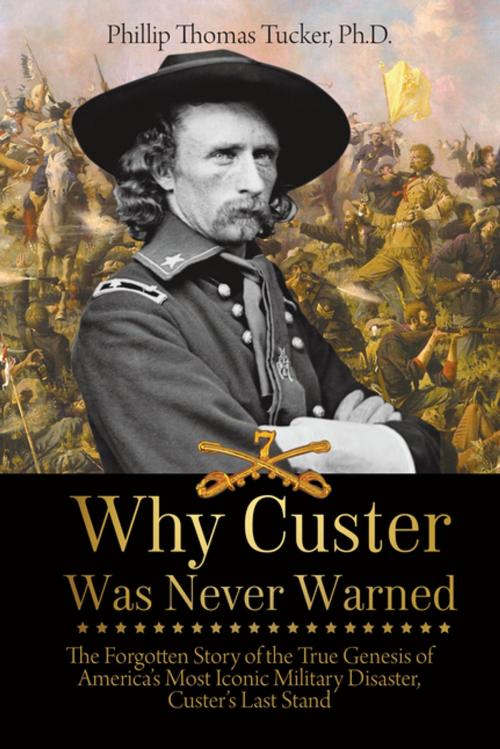Why Custer Was Never Warned
The Forgotten Story of the True Genesis of America's Most Iconic Military Disaster, Custer's Last Stand
Nonfiction, History, Americas, Native American, Military, Strategy, United States, Civil War Period (1850-1877)| Author: | Phillip Thomas Tucker | ISBN: | 9781627341028 |
| Publisher: | Universal Publishers | Publication: | October 1, 2017 |
| Imprint: | Universal Publishers | Language: | English |
| Author: | Phillip Thomas Tucker |
| ISBN: | 9781627341028 |
| Publisher: | Universal Publishers |
| Publication: | October 1, 2017 |
| Imprint: | Universal Publishers |
| Language: | English |
For the first time, this ground-breaking book tells the forgotten story of the true genesis of the June 25, 1876 disaster along the Little Bighorn, "Custer's Last Stand." The failure of the southern column to continue to advance north after the battle of the Rosebud set the stage for the annihilation of George Armstrong Custer and his five companies of the 7th Cavalry at the Little Bighorn. For nearly 150 years, almost everything possible already has been written about the fascinating story of "Custer's Last Stand" except the analysis and new views that have been emphasized in this most revealing book: the true causes and culprits of the bloody fiasco at the Little Bighorn on June 25, 1876 that shocked the American nation like no other post-Civil War event. Phillip Thomas Tucker, Ph.D., the author of nearly 30 books and including award winners, has contributed many fresh and new views about "Custer's Last Stand," revealing what has long been most often left out of the historical record. Where possible, Tucker has relied on primary source material, including period newspapers, to enlighten readers about the most forgotten and overlooked causes of Lieutenant George Armstrong Custer's and his command's annihilation in the bloody showdown along the Little Bighorn. These new explanations and fresh interpretations about how and why the battle of the Little Bighorn,perhaps the most controversial battle in American history, ultimately played out so disastrously like a Greek tragedy. Therefore, the author has exposed those individuals, America's leading military and civilian officials, who were most responsible for the greatest military disaster in the post-Civil War period. Dr. Tucker has presented the unvarnished truths about what really happened and exactly why by revealing the Machiavellian currents and dark threads of a needless war that had been artificially manufactured against the Sioux by America's top leaders, including the president, to gain their territory, especially the Black Hills. Tucker has presented the most forgotten story (literally the story inside the story) of the 1876 Sioux Campaign and "Custer's Last Stand." In this way, he has provided us with a new understanding of exactly why Custer died on a lonely hilltop beside his most faithful followers, revealing the most overlooked truths that have been long ignored. Even more, this ground-breaking book has demonstrated how Custer became the convenient scapegoat for the monumental disaster, while the true culprits in contrast successfully maintained their reputations and paths to career advancement. With considerable insight and a long-demonstrated penchant for myth-busting,Tucker has demolished the myth which stubbornly persists to this day that Custer was the foolish glory hunter, who deserved sole blame for the fiasco along the Little Bighorn. This book has overturned some of the oldest misconceptions and falsehoods to present a fresh look of George Armstrong Custer and one of the most controversial campaigns and battles in American history. For the first time and despite all of the voluminous amount of literature about Custer and the famous last stand, this book brings the reader of today much closer to a more accurate and truer understanding of how and why Custer and his five companies of the 7th Cavalry were wiped out to the last man on a hot summer afternoon in the Montana Territory.
For the first time, this ground-breaking book tells the forgotten story of the true genesis of the June 25, 1876 disaster along the Little Bighorn, "Custer's Last Stand." The failure of the southern column to continue to advance north after the battle of the Rosebud set the stage for the annihilation of George Armstrong Custer and his five companies of the 7th Cavalry at the Little Bighorn. For nearly 150 years, almost everything possible already has been written about the fascinating story of "Custer's Last Stand" except the analysis and new views that have been emphasized in this most revealing book: the true causes and culprits of the bloody fiasco at the Little Bighorn on June 25, 1876 that shocked the American nation like no other post-Civil War event. Phillip Thomas Tucker, Ph.D., the author of nearly 30 books and including award winners, has contributed many fresh and new views about "Custer's Last Stand," revealing what has long been most often left out of the historical record. Where possible, Tucker has relied on primary source material, including period newspapers, to enlighten readers about the most forgotten and overlooked causes of Lieutenant George Armstrong Custer's and his command's annihilation in the bloody showdown along the Little Bighorn. These new explanations and fresh interpretations about how and why the battle of the Little Bighorn,perhaps the most controversial battle in American history, ultimately played out so disastrously like a Greek tragedy. Therefore, the author has exposed those individuals, America's leading military and civilian officials, who were most responsible for the greatest military disaster in the post-Civil War period. Dr. Tucker has presented the unvarnished truths about what really happened and exactly why by revealing the Machiavellian currents and dark threads of a needless war that had been artificially manufactured against the Sioux by America's top leaders, including the president, to gain their territory, especially the Black Hills. Tucker has presented the most forgotten story (literally the story inside the story) of the 1876 Sioux Campaign and "Custer's Last Stand." In this way, he has provided us with a new understanding of exactly why Custer died on a lonely hilltop beside his most faithful followers, revealing the most overlooked truths that have been long ignored. Even more, this ground-breaking book has demonstrated how Custer became the convenient scapegoat for the monumental disaster, while the true culprits in contrast successfully maintained their reputations and paths to career advancement. With considerable insight and a long-demonstrated penchant for myth-busting,Tucker has demolished the myth which stubbornly persists to this day that Custer was the foolish glory hunter, who deserved sole blame for the fiasco along the Little Bighorn. This book has overturned some of the oldest misconceptions and falsehoods to present a fresh look of George Armstrong Custer and one of the most controversial campaigns and battles in American history. For the first time and despite all of the voluminous amount of literature about Custer and the famous last stand, this book brings the reader of today much closer to a more accurate and truer understanding of how and why Custer and his five companies of the 7th Cavalry were wiped out to the last man on a hot summer afternoon in the Montana Territory.















